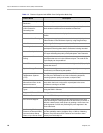
Polycom RealPresence Collaboration Server (RMX) 1500/2000/4000
1-2 Polycom, Inc.
The RealPresence Collaboration Server (RMX) 1500/2000/4000 Deployment Guide for Maximum
Security Environments provides a deployment methodology for system administrators
implementing Maximum Security Environments.
Who Should Read This Guide?
System administrators and network engineers should read this guide to learn how to
properly set up Polycom RMX systems. This guide describes administration-level tasks.
For detailed description of first time installation and configuration, description of the RMX
Web Client, and basic operation of your RMX system, see the RealPresence Collaboration
Server (RMX) 1500/2000/4000 Getting Started Guide.
Prerequisites
This guide assumes the user has the following knowledge:
• Familiarity with Windows® XP or Vista® operating systems and interface.
• Familiarity with Microsoft® Internet Explorer® Version 7 or higher.
• Basic knowledge of video conferencing concepts and terminology.
How This Guide is Organized
The following typographic conventions are used in this guide to distinguish types of in-text
information.
Table 1-1 Typographic Conventions
Convention Description
Bold Highlights interface items such as menus, soft keys, flag names, and
directories. Also used to represent menu selections and text entry to the
phone.
Italics Used to emphasize text, to show example values or inputs, file names and to
show titles of reference documents available from the Polycom Support Web
site and other reference sites.
Underlined Blue
Used for URL links to external Web pages or documents. If you click on text in
this style, you will be linked to an external document or Web page.
Blue Text Used for cross referenced page numbers in the same or other chapters or
documents. If you click on blue text, you will be taken to the referenced
section.
Also used for cross references. If you click the italic cross reference text, you
will be taken to the referenced section.
<variable name> Indicates a variable for which you must enter information specific to your
installation, endpoint, or network. For example, when you see <IP address>,
enter the IP address of the described device.
> Indicates that you need to select an item from a menu. For example,
Administration > System Information indicates that you need to select
System Information from the Administration menu.


















